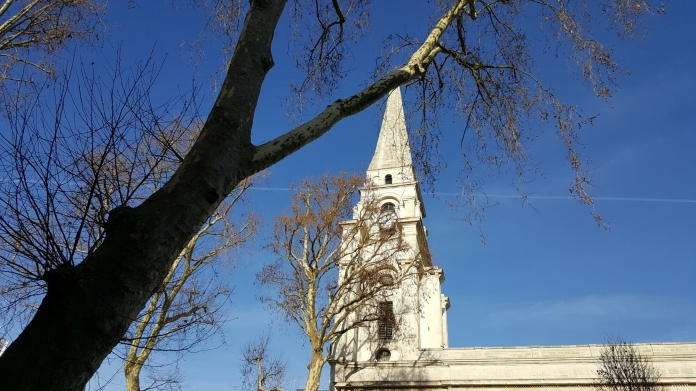Part of the argument of Owen Hopkins’s new book about Hawksmoor is that Hawksmoor influenced a generation of modern and postmodern architects, including Denys Lasdun, Robert Venturi and James Stirling. All those strong black-and-white shadows. As it happens, the only time I met Lasdun was at a dinner held to commemorate the death of Thomas Archer held, I think, in May 1983 and organised by, amongst others, Loyd Grossman who was planning to do a PhD on Archer:-
Monthly Archives: December 2015
Wickham’s Department Store
I have seldom seen Wickham’s look so magnificent as it did this morning in the winter sun, its tower seen from a distance alongside the line of plane trees planted in 1910 on Mile End Waste:-
Jubilee Street
There are good surviving nineteenth-century terrace houses on Jubilee Street, as well as being the former site of the New Alexandra Hall, where Lenin spoke on 21 March 1903 at a meeting to celebrate the 32nd. anniversary of the Paris Commune and which was then leased by an anarchist club. No.193 was lived in, according to the 1881 Census, by John Abbott, a cowkeeper and owner of Abbott’s Yard behind with a dairy which supplied fresh milk to the City:-
37 Stepney Green
I have managed to acquire a second-hand copy of a Central Stepney History Walk, written by Tom Ridge and published by the so-called Central Stepney Regeneration Board in 1998. It has a usefully concise account of the previous owners of 37, Stepney Green, the grandest of the houses in the neighbourhood. It was built for Dormer Sheppard, a London merchant and slave owner who twice advertised for the return of ‘a black Boy named Lewis, about 15 years old, in a Fustian Frock with Brass Buttons, Leather Breeches and blue stockings’. In 1714, it was bought by Lady Mary Gayer, the widow of General Sir John Gayer who had been Governor of Bombay. From 1757 to 1763, it was owned by Lawrence Sulivan, a Director and Chairman of the East India Company, from 1764 to 1811 by Isaac Lefevre, a banker and distiller, and, from 1812 to 1819, by Nicholas Charrington, proprietor of the local brewery. It ended up as a Jewish Home, then The Craft School, and finally Council Offices before being sold to the Spitalfields Trust in the mid-1990s:-
LDDC
The reason I was given Andy Beckett’s book is that it has the best recent account of the founding of the LDDC. I had always thought that the LDDC was Heseltine’s baby. It turns out that the idea was at least as much Geoffrey Howe’s, based on a meeting of the Bow Group at the Waterman’s Arms in June 1978 which led to the idea of an Enterprise Zone, free of planning restrictions. The LDDC itself was founded in November 1980 with Reg Ward as its first Chief Executive and its headquarters in a Norman Foster building in Millwall Docks designed as the passenger terminal for Fred Olsen Lines in 1969, one of his first major buildings, since demolished (it’s oddly not recorded in the practice’s list of projects). LDDC’s first projects were the red roads, new housing in Beckton (Savage Gardens) and Limehouse studios designed by Terry Farrell in a playful postmodern style on the site of one of the banana warehouses.
The early 1980s
I have spent the day reading Andy Beckett’s very lively analysis of the early 1980s, Promised You a Miracle UK80-82, my Christmas present from Otto. I find it odd to read an analysis of a period I lived through. Some of it is familiar: Chariots of Fire; the success of Brideshead Revisited; Greenham Common; the Royal Wedding; the Sloane Ranger Handbook; the New Romantics; the rise of individualism; the Right to Buy; the invasion of the Falklands. But I don’t remember anyone being especially worried about the threat of nuclear war. What I remember most vividly was sitting in south London watching the 1979 election and two friends describing, extremely cogently and much to my surprise, why they hoped that Thatcher would win.
Spitalfields Trust
In honour of my visit to Norton Folgate, we watched an archival programme, dating from 1985, about the middle-class settlers in Spitalfields. It shows Dennis Severs expounding his philosophy of historical reconstruction, Dan Cruickshank describing the original circumstances of construction of Elder Street, and Eric Elstob talking about moving into Fournier Street, but, best of all, it has Douglas Blain describing the origins of the Spitalfields Trust, which involved a squat in Elder Street in 1977 and the occupation of the offices of British Land until they allowed the sale of two of the original Elder Street houses. Blain says that one day people will be grateful for the work of the Spitalfields Trust in preserving historic properties. We are, Douglas, we are.
Fournier Street
I know I’ve done blogs on Fournier Street before, but I still can’t resist photographing its beautiful, still surviving door surrounds and remembering that this part of Spitalfields, now as lush and prosperous as a New England village, wasn’t necessarily going to survive forty years ago:-
Christ Church, Spitalfields
I spent part of Christmas reading Owen Hopkins’s admirable short monograph From the Shadows: The Architecture and Afterlife of Nicholas Hawksmoor, which made me look afresh at Christ Church, Spitalfields in the light of his very clear account of the way that Hawksmoor was influenced by the interest of his eccelesiastical contemporaries in the churches of the Primitive Christians, which may have given Hawksmoor some of his characteristics of bold, unornamented, structural clarity:-
Elder Street
In order to understand the nature of the argument surrounding the development of Norton Folgate, it is important to see it in the context of Elder Street, one of the best of the surviving Spitalfields streets, where Mark Gertler lived and later Raphael Samuel and now Dan Cruickshank. The city looms nearby. But there is still a domestic presence resisting the incursion:-















You must be logged in to post a comment.